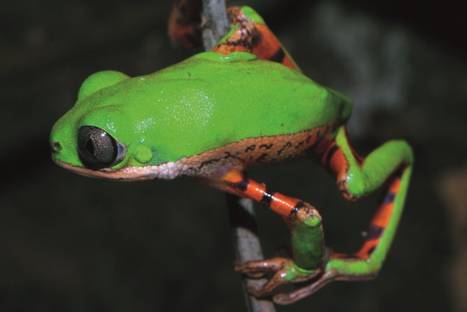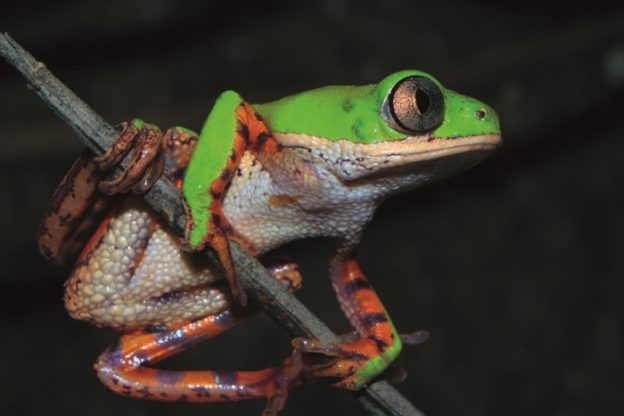
The red-eyed tree frogs of the genus Agalychnis are among the most popular of all terrarium frogs. In order to satisfy the constant demand, practically all red-eyed tree frogs are captive-bred nowadays. The leaf frogs of the genus Phyllomedusa are closely related to the red-eyed tree frogs, but much less well known. A pity, as they too include wonderful frogs for the terrarium!
The genus Phyllomedusa currently includes 30 generally accepted species that are distributed in South and Central America. One of them, Phyllomedusa hypochondrialis, will be discussed in some detail. Its distribution encompasses eastern Colombia, northern and eastern Venezuela, the Guianas, and the whole of Brazilian Amazonia. Within this vast distribution region this adaptable species is widely found in association with human settlements and considered not to be endangered.
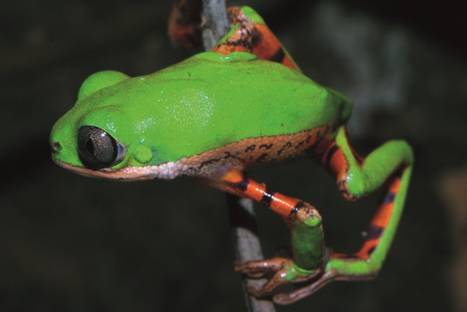
Not a rainforest-dweller
Of all the species of the genus Phyllomedusa, those least adapted to the rainforest are the up to around 5 cm long Phyllomedusa hypochondrialis (females grow somewhat larger than males) and its close relative P. azurea, which has an adjacent distribution to the south. (The two of them are sometimes regarded as subspecies of one and the same species, P. hypochondrialis.) This also explains their success in the modern world. Their habitat is bush and scrub vegetation in seasonally flooded grassland, as well as dry woodland. These frogs have a special adaptation to this comparatively dry (by day) habitat – during the day they coat themselves with a waxy layer that protects them from dehydration.
This doesn’t mean of course that these frogs should be kept in a desert terrarium. They too require a relative humidity of 60-80% at 24-26 °C by day, while at night the humidity rises as the temperature drops to 20-22 °C. But Phyllomedusa do require dry resting places, as otherwise there is a risk of disease. There should always be a bathing dish with constantly fresh (but aged) water available in the terrarium.
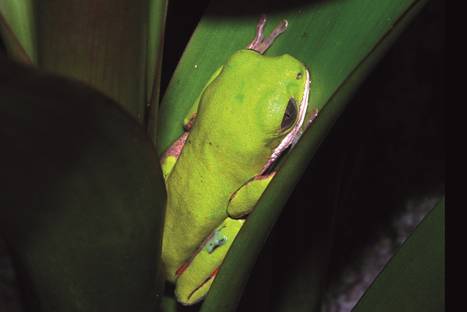
Climb like monkeys
These frogs hardly ever hop, they climb! They don’t have webbed feet and can grip because the first two toes are opposed to the others. This means that Phyllomedusa hypochondrialis can also clamber along quite slender twigs. These medium-sized frogs do exceptionally well in a terrarium with varied planting as the plants will be virtually unaffected by the frogs. The size of the terrarium should be around 50 x 50 x 80 cm (length x breadth x height).
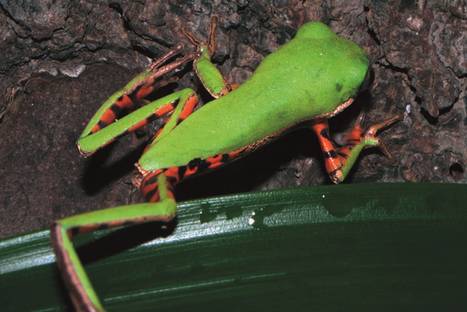
Readily bred
The species-rich tree-frog family (Hylidae) is divided into several subfamilies. Phyllomedusa belong to the Phyllomedusinae. All members of the subfamily Phyllomedusinae whose mode of reproduction is known spawn in the same way, out of water. They deposit their spawn in bags which they construct from leaves overhanging a pool. When the tadpoles are ready to hatch the gelatinous mass surrounding the eggs liquifies, and the tadpoles drop into the pool, where their further development takes place. In order to make all this work properly in the terrarium we have to simulate a dry period and a rainy season, as these frogs spawn only during the rainy season in the wild. In the case of Phyllomedusa hypochondrialis the daytime temperature is raised to 29-32 °C during the dry phase. Two weeks are sufficient to condition the frogs. They are then transferred to a “rainfall tank” where they usually start to spawn very quickly. Fenolio (1996) portrays P. hypochondrialis as the fastest of all frog species to respond to rainfall! Spatyphyllum or Monstera can be offered as spawning plants. It is a good idea to use plants raised in hydroculture in order to avoid potting compost getting into the water. Care must always be taken in setting up the rainfall tank, as Phyllomedusa hypochondrialis are very poor swimmers and can easily drown.The tadpoles can usually be reared without problem using flake food for aquarium fishes. Alder cones in the water and peat filtration are very helpful in keeping the water in the rearing tank stable. If you are now filled with the desire to keep and breed Phyllomedusa hypochondrialis, then your pet dealer can undoubtedly order some for you from a wholesaler of his acquaintance, for example Tropenparadies in Oberhausen, Fax +49 (0)208-665997.
Anzeige






